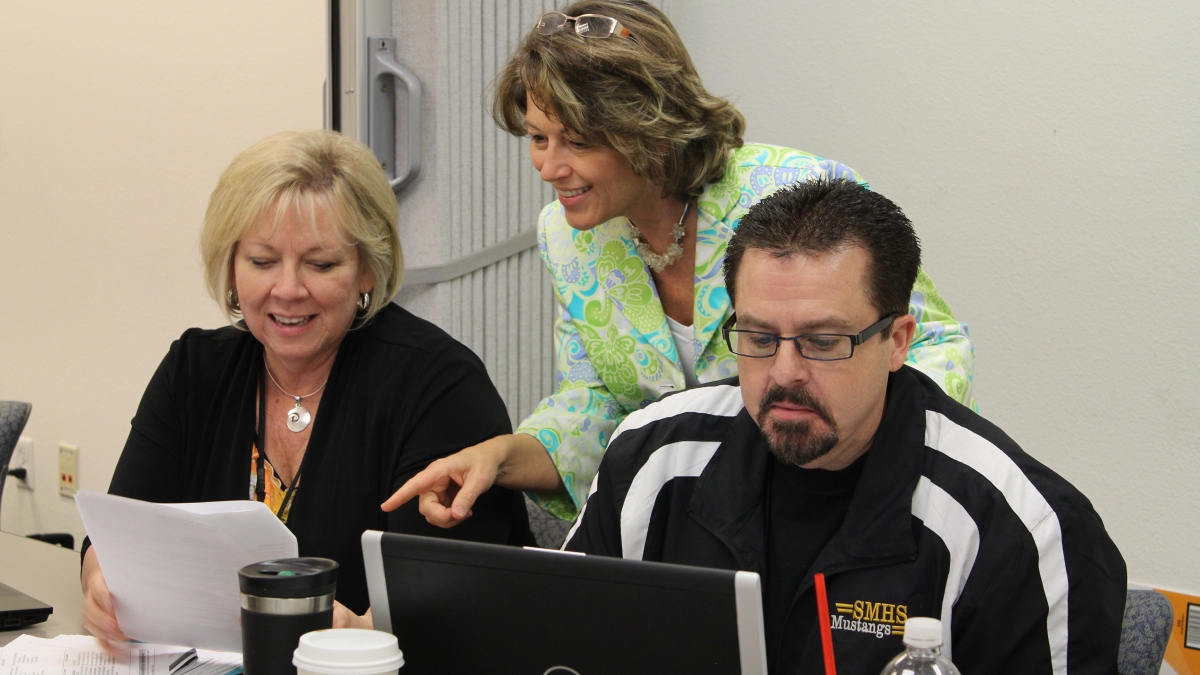Partnership targets success in first-year composition

It’s a simple idea – direct communication among high school and university faculty to help students make the transition to higher education. Thanks to a collaborative effort between ASU’s New College of Interdisciplinary Arts and Sciences and the Peoria Unified School District (PUSD), this idea has been transformed into action to prepare the district’s graduates for success in ASU’s first-year composition classes, English 101 and 102.
“The Peoria school district has always strived to prepare students for post-secondary success,” said Debbie LeBlanc, the district’s curriculum specialist for high school language arts. “In the last few years, we have been collecting data from our surrounding community colleges and universities to find out how Peoria’s students have fared. We know many students do well, but we want all students to have the opportunity to be successful if they choose to continue their education at a college or university.”
This commitment led the district to reach out to New College’s Division of Humanities, Arts and Cultural Studies (HArCS), which houses the first-year composition program. New College is the core college on ASU’s West campus. Face-to-face meetings were held among high school English teachers and first-year composition faculty so they could engage in dialogue about expectations of students in ENG 101 and 102, and how the district’s curriculum might evolve to help students be ready to meet those expectations.
“One of our major points of focus, as we move forward, will be to make our first-year composition program more profoundly engaged with the community,” said Marlene Tromp, HArCS division director. “We hope to develop real and meaningful connections and to craft our writing program so that it serves the surrounding community as much as our own students.”
According to Sherry Cisler, interim director of first-year composition in HArCS, the collaboration is an intrinsically valuable approach to learning how ASU and PUSD can best serve the needs of their students as they shape attitudes, approaches and practices to lifelong learning and literacy.
“The opportunity to discuss approaches to rhetoric, methods of teaching and desired outcomes with PUSD English faculty presents a valuable means of learning the kinds of experiences, preparation and knowledge our first-year students bring with them to the ASU composition classroom,” Cisler explained.
LeBlanc said the collaboration project reinforced the importance of research skills. The district had just started requiring all seniors to complete a research paper.
“This forced teachers to drop some items from their curriculum and, at first, this was difficult for them,” LeBlanc said. “However, after the collaboration session, they realized how absolutely essential research skills are to post-secondary education, let alone real life. How many times will students have to research which doctor to choose, which insurance plan to pick, which apartment to rent? The research skills taught to seniors will serve them well in their future career or college experiences as well as in the real world.”
PUSD will devise a new curriculum that incorporates the new Arizona 2010 English Language Arts Standards, which were developed by a national group to help all students reach post-secondary success. All districts in the state must fully implement the standards by 2013 to be ready for new assessments based on these standards, which will be given for the first time during the 2014-2015 school year.
“The interactions with New College faculty made us realize that from a district perspective, we needed to support teachers better in their efforts to prepare students for a variety of post-secondary experiences,” LeBlanc said. “The first item on our list is to create a 21st century curriculum that incorporates the English Language Arts Standards. We will be working on the new curriculum all summer.”
The ASU-PUSD collaboration has already made an impact on individual teachers in the district.
“The key idea I took from meeting with ASU was that students will be better prepared for college if they have quality research skills,” said Leslie Hunter, who teaches English at Sunrise Mountain High School.
“This includes conducting effective searches, finding different formats of information, and knowing how to interpret search results,” Hunter said. “We have tried to stress that more in our Language Arts department. It also was validating to me as a high school teacher who tries very hard to get students to be accountable, to hear that at the college level, students need to be more self-reliant. In other words, they need to be more responsible for their own learning.”
According to Cisler, the most recent ASU-PUSD discussions evolved into a collaboration among ASU, PUSD and Glendale Community College.
“This shows that PUSD clearly appreciates and embraces the crucial role their faculty have in preparing their composition students for college success, and ASU and GCC welcome the opportunity to work closely with PUSD in meeting these collective goals,” she said. “We welcome any opportunity to partner with other districts to increase levels of literacy in preparation, practice and achievement within our shared communities.”
In fact, first-year composition faculty also have met with the English faculty from Sandra Day O’Connor High School in the Deer Valley Unified School District to discuss writing projects, objectives and outcomes common to ASU’s writing program. The goal is similar to that of PUSD, prepping students to meet college-level expectations and easing the high school to college transition.